Jali Door Designs | Criss-Cross | Traditional Style | Ornate Jali | Intricate Woodwork | Wood Panelled Jali | Moroccan Jali | Contemporary | Garden Jali | Bold Design | Honeycomb Jali | Benefits | Conclusions
In India, the jali door design has long been an intrinsic part of Indian architecture. The word ‘jali’ originates in Sanskrit and means ‘net.’ The jali is a window or latticed screen that has been carved by artisans in either wood or stone.
The concept of jali design is largely found in Islamic and east-Asian architecture. Originally, it was developed as an architectural solution for battling extreme heat in arid climates and also for regulating light. The intricate geometric designs that are a part of the jali work have since become a coveted symbol of beauty.
Jali is the craftsman’s portrayal of a spider’s web, and just as delicately carved and full of detail. Well-made jali designs delight the senses with a play of the elements, namely, light and shadow. Intricately designed jalis generated an aura of mystery and grandeur in many ancient Indian Havelis.
Aside from serving a decorative purpose, it is also useful. Through it, the artists create various unique forms of expression.
The world-renowned monument, the Taj Mahal, uses the jali design to good effect allowing for circulation of air circulation and keeping the interior cool even on a hot day. They help filter out harsh sunlight while allowing natural light to shine in every corner of the structure where they are installed.
Come, let’s take you on a journey to explore the many mesmerising wooden jali door designs available for Indian homes.
10 Wooden Jali Door Designs
1. A Jali Door with a Criss-Cross Pattern
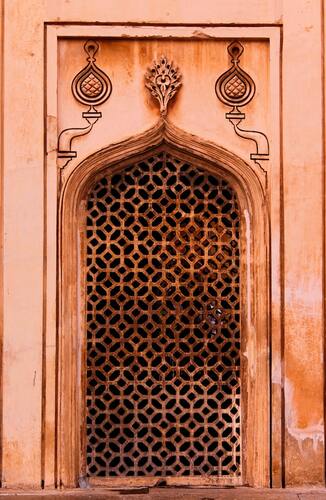
A minimalist jali design, though basic, is highly functional. The criss-cross design is meticulously constructed, allowing natural light to reach every room corner. The simple frame will reduce your material usage, and the basic grill pattern will cost less when compared to curved designs.
2. Wooden Jali Door Design in the Traditional Style
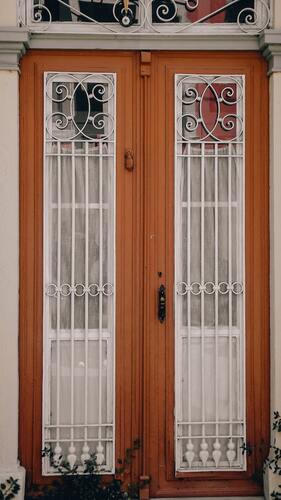
A jali door design made with wood and metal inlay for the main door of your home looks grand and will be the cynosure of all eyes.
If you have a keen eye for the timeless combination of wood and metal, needless to say, this design will catch your eye. Aside from being gracefully simple, the minimal design will reduce the material you use, and the basic grill design will be easy on your pocket. Combining it with bronze or dull gold finish will enhance the overall beauty of the door.
As the double door is made of good quality wood, it is suitable for homeowners that are looking for a central double door jali design and is perfect for Indian homes.
3. Ornate Jali Door
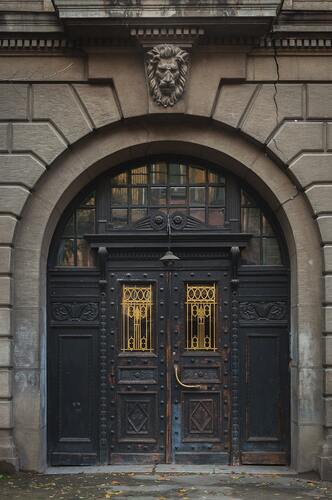
The heavy-duty ornate wooden jali door design is both robust and graceful. The delicate gold jali over the glass is a captivating design, and the side pillars enhance the formidable look of these magnificent doors.
4. Jali Door Designed with Intricate Woodwork
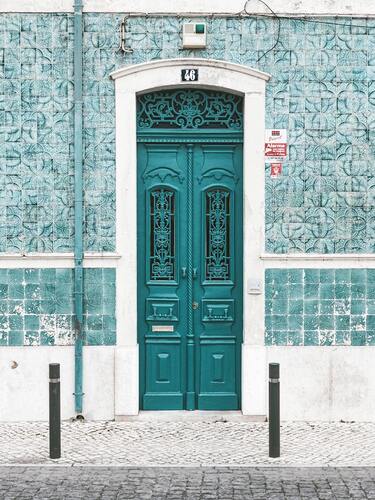
These kinds of coloured wooden jali door designs give off a rustic look that is back in vogue and much sought after these days. Detailed work above the jali-fitted windows is aesthetically pleasing, and the woodwork you find on the door smoothly integrates with the rest of the pattern.
This design has rectangular blocks affixed with the jali on each of the doors. Minimal usage of jali ensures both privacy and gives the door a unique look. It is an interesting departure from the usual monotony of all wooden doors that one would typically notice in Indian houses.
5. Wood Panelled Jali Door Design

A jali door design based on wood panelling that serves as the main door has a certain simplicity and yet gives off a certain elegance. It aids in improving the appearance of your home even before any visitor passes through and is a sight to behold from the street itself.
Notice that the panelling stretches to approximately ¾ th’s of the door, which gives the design a stylish and not a very commonly-found look.
6. Moroccan Jali Door Design

Moroccan architectural influence can be found worldwide. Wooden jali door designs are now available on Indian shores too and are a popular choice of many Indian homes. Many people flock to use this design thanks to its mystical orient vibe and beauty. It is, without a doubt, one of the most popular jali designs that homes in India use.
The Moroccan jali pattern adds a regal touch to the main entrance of any home that uses it. The door lends an air of importance and luxury to a home when any eye befalls it.
7. Contemporary & Chic Jali Wooden Door Designs
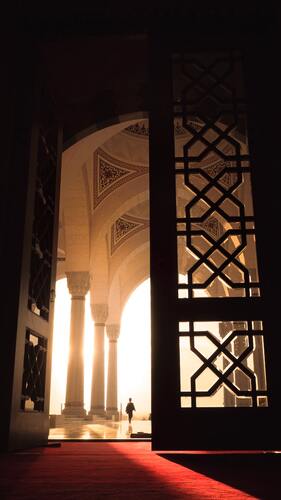
The chevron pattern is a great decor pattern so far, used chiefly in drapes, carpets and other similar furnishings. Now you can find it in a jali door designed with wood near you, and it doubles up spectacularly as a grill pattern too.
East-European architecture inspires this design, and it is wonderfully elegant. So let go of your reservation and choose this design from your home. You will thank us for it!
Unlike the more traditional designs, this pattern lends a contemporary vibe that is ideally for apartments that ask for a minimalist look.
8. Jali Wooden Door Design For Decorating your Garden
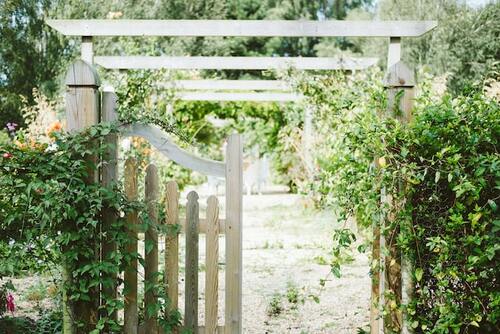
Jali door designs made of wood are very versatile products. Apart from homes, both inside and for the threshold, they can be used for gardens too. A white picket fence-style jali door will blend in with your garden naturally. Additionally, it will provide character to the already beautiful environs of your home.
9. Bold & Beautiful Jali Wooden Door Design

Who says doors have to be mundane in appearance? Let that be for others! Be sure to spruce up the appearance of your abode with a bold and colourful jali design door, just like the bold design you see here.
Let go of your inhibitions and embrace your quirky and fun side. It will make a great impression and serve as a conversation started with your neighbours. After all, how many red doors do you see? Having one will make you unique.
10. Honeycomb Jali Wooden Door Design
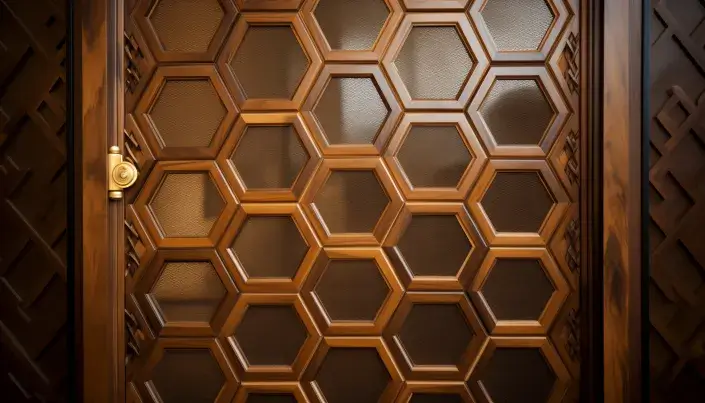
The honeycomb design is a natural crowd pleaser and is sure to look appealing should you choose to pick it to design your wooden jali door. You may pick it up for entry to your residence or as a door for any of the rooms at your home. The door frame options are available in a wide range of colours that you may pick from according to your fancy.
A beautiful jali door design, such as the honeycomb design, will make an excellent addition to your lovely home.
Benefits of Jali Design
The jali pattern is no passing trend and is here to stay. It has not only survived but also evolved and thrived over the centuries as it is an ideal combination of form and function. The humble jali can be used for partitions, doors and even ceilings.
Some of its advantages are:
- It is a helpful way to segregate space but doesn’t take up too much of it.
- A jaali blocks neither air nor light.
- It makes for an aesthetically pleasing statement and is affordable decor too.
- There are no prerequisites to using jaalis at home, and they can fit seamlessly into any home.
Conclusion
Though jali designs and patterns differ between regions, the essence of the artistry remains the same wherever it may be. Some refer to it as poetry in stone as it evokes a sense of wonder and awe in many. And even though the jali mostly serves a functional requirement in our homes and offices, its grandeur and delicate nature, along with its vibrancy, are unmistakable. The jali was patronised plenty by the royals in their time.
Whether it has found a place on balconies, terraces, platforms, or even found use as decorative screens, it has slipped effortlessly into any role in the places we dwell.
The jali designs flourished during the 16th to 18th centuries in north India, as it was a medium for women to catch a glimpse of the outside world without any inquisitive eyes invading their privacy. The lattice screens saw them being used as window screens or dividers within rooms to restrict access to queens, princesses and other women of the palace. Thus the jali was a purdah in its own right.
